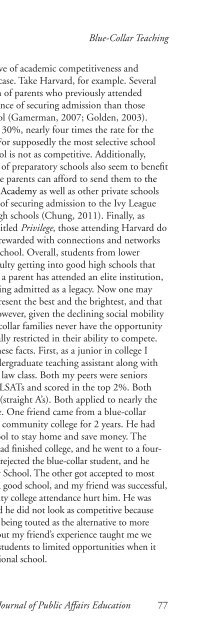WINTER 2012 - National Association of Schools of Public Affairs and ...
WINTER 2012 - National Association of Schools of Public Affairs and ...
WINTER 2012 - National Association of Schools of Public Affairs and ...
Create successful ePaper yourself
Turn your PDF publications into a flip-book with our unique Google optimized e-Paper software.
Sharing Student Research with the World<br />
Behrman, 2007; Schacter & Schwarz, 2009; Shields & Tajalli, 2006) in public<br />
administration/public affairs education. In a similar vein, this study looks at the<br />
download rates <strong>of</strong> capstone papers at Texas State University <strong>and</strong> examines its<br />
implications for public administration pedagogy, research, <strong>and</strong> practice.<br />
OPEN ACCESS DIGITAL REPOSITORIES<br />
Open access digital institutional repositories are a relatively new technology<br />
that universities are using to become more engaged in scholarly communication.<br />
Scherlen <strong>and</strong> Robinson (2008, p. 58) define open access as<br />
free availability <strong>of</strong> scholarly literature on the public internet, permitting<br />
anyone to read, download, copy, distribute, or print the full text<br />
without restrictions (other than to give authors control over the integrity<br />
<strong>of</strong> their work <strong>and</strong> the right to be properly acknowledged <strong>and</strong> cited).<br />
When scholarly communication was trapped in paper, 2 its availability was<br />
limited to those with access to the library (<strong>and</strong> copy machine). Once scholarly<br />
communication was digitized, it was able to move easily; <strong>and</strong> well outside the<br />
walls <strong>of</strong> the library. Note that scholarly communication is an umbrella term that<br />
describes communication such as faculty authored journal articles, conference<br />
papers, monographs, student works, <strong>and</strong> administrative documents.<br />
The complicated, short history <strong>of</strong> open access digital repositories cannot be<br />
captured here. Nevertheless, it should be noted that online storage costs dropped<br />
<strong>and</strong> st<strong>and</strong>ards <strong>of</strong> digital preservation came together so that libraries looked at<br />
open access digital repositories as a way to preserve <strong>and</strong> distribute the scholarly<br />
communication produced by faculty, students, <strong>and</strong> programs (Lynch, 2003).<br />
Changes in technology made repositories more affordable (Lynch, 2003, p. 327).<br />
Lynch (2003, p. 328) defines a university-based digital repository as<br />
a set <strong>of</strong> services that a university <strong>of</strong>fers to the members <strong>of</strong> its community<br />
for the management <strong>and</strong> dissemination <strong>of</strong> digital materials created<br />
by the institution <strong>and</strong> its community members. It is most essentially<br />
an organizational commitment to the stewardship <strong>of</strong> these digital<br />
materials including long-term preservation where appropriate, as well<br />
as organization <strong>and</strong> access or distribution.<br />
When mature, university repositories would contain the “intellectual works <strong>of</strong> faculty<br />
<strong>and</strong> students.”<br />
While universities want to preserve <strong>and</strong> distribute their scholarly communication,<br />
they do not want to clutter the Internet with marginal or poor scholarship.<br />
Hence, scholarly communication should have some kind <strong>of</strong> quality control<br />
(Levin et al., 2005).<br />
Journal <strong>of</strong> <strong>Public</strong> <strong>Affairs</strong> Education 159

















